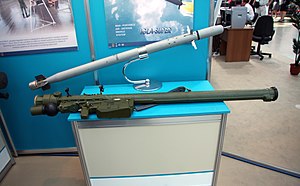9K38 Igla
| Igla | |
|---|---|

Igla missile and launch tube.
|
|
| Type | Man-portable air-defense systems (MANPADS) |
| Place of origin | Soviet Union |
| Service history | |
| In service | 1981–present |
| Used by | See Operators |
| Production history | |
| Manufacturer | KB Mashinostroyeniya – developer of the system |
| Produced | 1981–present |
| Specifications | |
| Weight | 10.8 kg (24 lb) |
| Length | 1.574 m (5.16 ft) |
| Diameter | 72 mm |
| Warhead | 1.17 kg (2.6 lb) with 390 g (14 oz) explosive |
|
Detonation
mechanism |
contact and grazing fuzes |
|
|
|
| Engine | solid fuel rocket motor |
|
Operational
range |
5.2 km (3.2 mi) |
| Flight ceiling | 3.5 km (11,000 ft) |
| Speed | 570m/s (peak), about Mach 1.9 |
|
Guidance
system |
dual waveband infra-red (S-version) |
The 9K38 Igla (Russian: Игла́, "needle") is a Russian/Soviet man-portable infrared homing surface-to-air missile (SAM). "9K38" is the Russian GRAU designation of the system. Its US DoD designation is SA-18 and its NATO reporting name is ; a simplified, earlier version is known as the 9K310 Igla-1, or SA-16 . The latest variant is the 9K338 Igla-S, with NATO reporting name SA-24 Grinch. It has been fielded by the Russian Army since 2004.
There is also a two-barrel 9K38 missile launcher called Djigit.
The development of the Igla short-range man-portable air defense system (MANPADS) began in the Kolomna OKB in 1972. Contrary to what is commonly reported, the Igla is not an improved version of the earlier family (Strela-2 and Strela-3), but an all new project. The main goals were to create a missile with better resistance to countermeasures and wider engagement envelope than the earlier Strela series MANPADS systems.
Technical difficulties in the development quickly made it obvious that the development would take far longer than anticipated, however, and in 1978 the program split in two: while the development of the full-capability Igla would continue, a simplified version (Igla-1) with a simpler IR seeker based on that of the earlier Strela-3 would be developed to enter service earlier than the full-capability version could be finished.
The 9K310 Igla-1 system and its 9M313 missile were accepted into service in the Soviet army on 11 March 1981. The main differences from the Strela-3 included an optional Identification Friend or Foe system to prevent firing on friendly aircraft, an automatic lead and super elevation to simplify shooting and reduce minimum firing range, a slightly larger rocket, reduced drag and better guidance system extend maximum range and improve performance against fast and maneuverable targets, an improved lethality on target achieved by a combination of delayed impact fuzing, terminal maneuver to hit the fuselage rather than jet nozzle, an additional charge to set off the remaining rocket fuel (if any) on impact, an improved resistance to infrared countermeasures (both decoy flares and ALQ-144 series jamming emitters), and slightly improved seeker sensitivity.
...
Wikipedia
